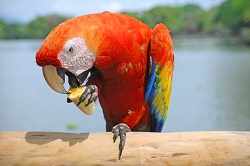Trending Science: Being ‘bird-brained’ is actually a compliment as densely packed neurons give birds an intellectual edge
Some birds excel at tasks believed to require ‘higher thought’, such as planning for the future, using tools, the ability to count, and recognising themselves in mirrors. These birds can achieve these challenges at a level that matches or exceeds primates’ problem-solving skills, despite having brains that are several times smaller. In the past, scientists have suggested that bird brains are wired in a completely different way than primates, a theory that was disproved two years ago in a study examining pigeon brains. A team of scientists from Charles University in Prague and Vanderbilt University in Nashville, Tennessee, may have an answer – they studied 28 bird species and found that songbirds and parrots can have as many or more neurons packed into their brains (specifically the forebrain region associated with more complex activities) than mammals. These tiny and densely-packed and highly-connected neurons are thought to give birds cognitive abilities that may far outstrip expectations and may even exceed the capacities of primates with similar-sized brains. In summary, the researchers suggest that birds’ brains may provide much higher cognitive power per unit mass than mammalian brains. The research team bought or captured a variety of birds, ranging from starlings and zebra finches to jackdaws and parakeets, and set about examining their brain structures. After removing the brains, the scientists targeted the pallium, a structure in birds’ brains that is analogous to the mammalian cerebral cortex. In mammals, larger neurons help connect far-away brain regions, but at the cost of density. Birds get around this trade-off by keeping most of their neurons closer together and growing a select number of larger neurons to handle long-distance communication. The macaw’s brain is no larger than a walnut, but it has more neurons forebrain, crucial for intelligent behaviour, than the macaque, which has a brain the size of a lemon. Both sulphur-crested cockatoos and bushbabies have brains that weigh about 10g, but the cockatoo has two billion neurons in its brain, twice as many as the bushbaby. Parrots, songbirds and corvids (that include ravens, crows and rooks) had the highest density of neurons in their forebrains. In effect, what the bird lacks in size, they more than make up for it in the sheer number of brain cells that they possess. ‘For a long time, there has been this stigma that birds have rather small brains but are actually incredibly clever,’ commented Pavel Němec, one of the members of the research team. ‘They are able to do things that we once thought only apes and mammals could do. There was a mismatch between their brain size and their cognitive abilities.’ This is not the first time that birds have surprised researchers with their unexpected intelligence. In 2002, a team at the University of Oxford were shocked when a New Caledonian crow bent a piece of wire and used it as a fishhook. Other birds have also shown highly advanced abilities, from the counting skills of African grey parrots to the ability of magpies to recognise their own reflections. The findings of this particular investigation have been published in the journal ‘Proceedings of the National Academy of Sciences.’ Němec is now moving on to analyse the brains of even more birds, including pigeons, waterfowl and chickens. He later hopes to study how their brains are wired-up. ‘We would like to look at whether avian neurons have similar numbers of connections to those in primates, but that is for a large future project,’ he concluded.
Countries
Czechia, United States



